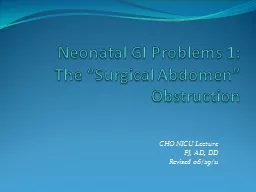

The Surgical Abdomen Obstruction CHO NICU Lecture PJ AD DD Revised 062911 Causes of GI Obstruction Upper Tract Esophageal atresia tracheoesophageal atresia Gastric causes ID: 777216
Download The PPT/PDF document "Neonatal GI Problems 1:" is the property of its rightful owner. Permission is granted to download and print the materials on this web site for personal, non-commercial use only, and to display it on your personal computer provided you do not modify the materials and that you retain all copyright notices contained in the materials. By downloading content from our website, you accept the terms of this agreement.
Slide1
Neonatal GI Problems 1:The “Surgical Abdomen”Obstruction
CHO NICU Lecture
PJ, AD, DD
Revised 06/29/11
Slide2Causes of GI ObstructionUpper Tract
Esophageal atresia +/-
tracheoesophageal
atresia
Gastric causes:
antral
web, bezoar
Pyloric stenosis
Duodenal
atresia/stenosis,
annular pancreas
duodenal web
Malrotation
volvulus
Slide3Causes of GI ObstructionMid-Gut
Jejunal
atresia
Ileal
atresia
Meconium ileus (associated with cystic fibrosis)
Small bowel perforation
NEC
Adhesions, strictures
Intussusception
Appendicitis
Abdominal wall defects
Omphalocele
Gastroschisis
Slide4Causes of GI ObstructionDistal Gut
Colonic atresia/stenosis
Hirschsprung’s
disease
Meconium plug syndrome (associated with
Hirschsprungs
)
Small left colon syndrome (IDM)
Incarcerated inguinal hernia
Imperforate anus
Slide5Non-Surgical Causes of IleusSepsisUTI
Electrolyte abnormalities:
Hypokalemia
Hypermagnesemia
Drugs:
morphine
Slide6Intestinal Obstruction
Symptoms and findings might include
:
Abdominal distention
Emesis
(bilious
)
Tenderness
Visible
loops of bowel, abdominal wall erythema
Associated problems:
Respiratory compromise, apnea
Hypovolemia
, hypotension
Sepsis (NEC, perforation)
Electrolyte imbalance
Neutropenia (sepsis
)
Thrombocytopenia
(sepsis, perforation, bowel necrosis
)
Check for incarcerated inguinal hernia, imperforate anus
Slide7Treatment of Intestinal ObstructionNG/OG to low intermittent suction
Correct
hypovolemia
and hypotension
Third spacing into the lumen of the distended bowel
IV Fluids
D5/D10
with 1/2
NS
at 120-150 mL/kg/day
Correct electrolyte abnormalities and acidosis
Blood
culture and Antibiotics
Ampicillin
,
Gentamicin
,
Flagyl
(sometimes)
Respiratory
support for abdominal distension or apnea
Slide8TEF/EA
Slide9Slide10Slide11Tracheo-esophageal fistula and esophageal atresia
Slide12Esophageal Atresia & Tracheo-esophageal
Fistula Symptoms
Respiratory distress from aspiration
Poor handling of secretions: drooling, frequent suctioning, choking or other symptoms with feeding
Inability to pass OG/NG to stomach
Abdominal distention may occur with swallowing of air through TEF or due to associated anal atresia
Slide13Esophageal Atresia & Tracheoesophageal
Fistula Associated Problems
Prematurity
RDS, pulmonary aspiration
VACTERL (vertebral anomalies, anal atresia, cardiac anomalies, TEF, renal, limb)
Abdominal distention due to air passed through TEF can cause gastric perforation
Slide14Esophageal Atresia & Tracheoesophageal
Fistula:
Management
CXR with tube to the pharyngeal pouch
LIS to the pharyngeal tube
Blood culture, ampicillin and gentamicin
Manage respiratory
problems
Examine
for anomalies: VACTERL
Slide15Bilious Vomiting40% of babies with bilious vomiting require surgical interventionBilious vomiting in the neonate is due to mechanical obstruction until proven
otherwise
Slide16Malrotation1/5000 live births80% occur during 1st
month of
life
most
during the 1
st
week of life
Higher incidence in
males (2:1)
Normal exam early during course
Sx
of
obstruction:
Bilious
vomiting
Sx
of
bowel ischemia:
Bloody
stool, abdominal distension, tenderness, shock
Slide17Normal fixation of
mesentary
Slide18Malrotation with ObstructionFailure of fixation and rotation of midgut, small bowel, right colon, and transverse colon
Duodenal obstruction from Ladd’s bands
Slide19Malrotation with VolvulusSmall bowel twists around superior mesenteric artery, causing ischemia
Slide20Malrotation/VolvulusAbdominal XRay
Normal film -20%
Dilated duodenal bulb and paucity of distal bowel gas
Double bubble sign
Distal gas filled bowel loops; gas filled volvulus (obstructed mesenteric veins prevent absorption of gas
Slide21Slide22Slide23Slide24Duodenal AtresiaPolyhydramniosPartial obstructions: duodenal web, duodenal
stenosis
, annular pancreas
40% of cases associated with
trisomy
21
Most common gut
atresia
in
neonates
“Double bubble”
Slide25Slide26Slide27Hirschsprung’s DiseaseFailure to pass meconium in 1
st
24
hrs
Absence of ganglion cells in mesenteric plexus
Most commonly
rectosigmoid
junction
10% of cases involve entire colon
10% of cases associated with Trisomy 21
Slide28Slide29Slide30Hirschsprung’s DiseaseContrast enemaSuction biopsyOpen biopsy
Rectal irrigation
Colostomy
vs
primary pull-through
Slide31In Utero PerforationCaused by obstruction:
Meconium
Ileus
Hirschprungs
Volvulus
Early perforation leads to Ca
++
deposits
Later perforation may cause
ascites
, no Ca
++
Adhesions lead to obstruction
Slide32Slide33Meconium IleusUsually a manifestation of cystic fibrosis
20% of infants with CF present with
mec
ileus
Obstruction of proximal ileum by thick, sticky round
meconium
pellets
Absence of air fluid
levels
“
soap bubbles”
Complications
:
perforation
, peritonitis,
pseudocyst
,
ileal
atresia
/
stenosis
Slide34Meconium IleusContrast enema:Small colon
Filled with pellet-like
meconium
when contrast extends to IC valve
Contrast can wash out the obstructing plugs and
meconium
plugs
The diagnosis of CF should
be
ruled-out
Slide35Slide36Slide37Slide38Meconium Plug SyndromeDiagnosis of exclusionProbably same as "small left colon" syndromeTransient
disorder due to functional immaturity of colon
Common in IDM,
premies
, PIH, Mg Rx
Infants with CF may present with
mec
plugs, although
mec
ileus
most common
10-30% may have
Hirschsprungs
also
Slide39Meconium Plug SyndromePresent within the first 24 to 36 hours of age:Abdominal distention
Vomiting (bilious)
Failure to pass
meconium
Plain films show distal intestinal obstruction
Contrast enema usually shows:
distention of the right and transverse colon
transition near the
splenic
flexure to a narrow descending colon and
rectosigmoid
region
Meconium
within the colon
Main differential diagnosis is
Hirschsprung's
disease:
In
Hirschsprung's
disease,
aganglionic
colon is usually normal caliber
In
Meconium
Plug Syndrome, colon is usually small
Slide40Slide41